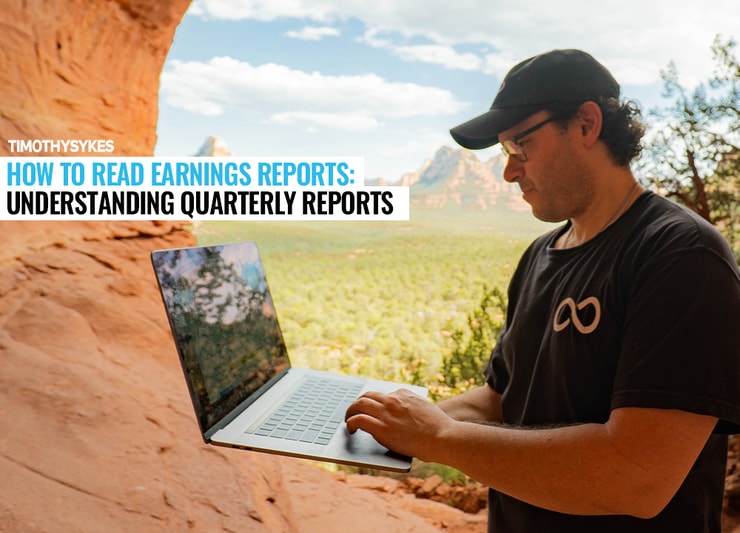If you want to be a savvy trader, you should know how to read earnings reports.
Earnings reports provide insight into a company’s financial health. They can also have a lot of influence on a stock’s price.
Earnings reports can be a great resource for traders to analyze the value of a company’s stock.

In this post, I’ll help you decode the sometimes confusing world of earnings reports. I’ll give you an overview of where to find earnings reports, what’s in one, and how you can use the information in it to help with potential trades.
Let’s do this!
Table of Contents
- 1 What Is an Earnings Report?
- 2 Why Do Earnings Matter?
- 3 Where to Find Earnings Reports
- 4 How to Read Earnings Reports: The Components of the Quarterly Report
- 5 Why Traders Need to Take a Closer Look at Earnings Announcements
- 6 Frequently Asked Questions About How to Read Earnings Reports
- 7 The Bottom Line on Reading Earnings Reports
What Is an Earnings Report?

2025 Millionaire Media, LLCThe term ‘earnings report’ generally refers to a quarterly earnings report.
This report — which, as the name implies, is filed quarterly — can be an incredible resource for reviewing a company’s overall performance.
An earnings report can have a huge impact on the company’s stock price. Usually, the company and/or analysts have issued projections for what they expect the report to show.
If the earnings don’t meet the projected target, the company and its stock can take a hit. But if they exceed projections, that can drive up the stock price and create momentum.
It’s not an exact science … It all depends on how the market perceives the data.
If the company lost money, but they lost less than analysts thought they would, it can be perceived as good news and the stock price can go up.
That’s why I always wait to react to earnings. I never try to anticipate earnings or buy in anticipation before they’re released. Never try to predict the market.
What’s Included in an Earnings Report?
So what does this big, important report include?
A quarterly report might include things like net income, net sales, earnings from operations, and earnings per share (EPS). There are also updates to vital financials, including the income statement, balance sheet, and cash flow statement. I’ll go into these terms more, later in this post…
The earnings report might include a side-by-side comparison of the numbers. That way, you can compare the company’s earnings report for this quarter against previous quarters.
It might come with a statement from the president or chief executive officer explaining the company’s progress.
Overall, the quarterly report gives a snapshot of the company in the latest quarter.
The quarterly earnings report is a fundamental research bible. It’s a great way to help analyze a company’s health and value.
You can typically find the exact date and time a company’s quarterly earnings report will be released. If you don’t see it online, you can contact the company. Great traders aren’t shy about doing this, because they always want to have an edge.
But the earnings report isn’t the only thing to review. A few weeks after, something called the 10-Q filing is released…
What’s a 10-Q Filing?
As important as the quarterly earnings report is, don’t just take it at its word.
While earnings reports are generally trustworthy, the fact is that companies want to paint the most positive pictures of themselves.
Because of this, they may put a positive spin on their business even if it’s experiencing some issues. So it’s important to delve deep and also read the Form 10-Q.
The 10-Q is kind of a cheat sheet for fact-checking the quarterly earnings report and confirming the cold, hard facts. It’s also legally required and must be filed with the Securities and Exchange Commission (SEC) every quarter.
Where the quarterly report can gloss over certain details, the 10-Q presents the information in a very black-and-white way. It’s a comprehensive report with details about the data in the quarterly earnings report. It elaborates on financials including the income statement, balance sheet, deficit for stockholders, and cash flow.
It also includes details about management’s analysis of the results and addresses risks in the market and any potential legal proceedings.
The 10-Q isn’t light reading — these documents are often more than 100 pages.
Because it’s dense material, companies often issue press releases about the 10-Q report to summarize it in bullet points for investors. They also usually try to put a positive spin on any details.
It can be tempting to just read the press release for the important points. But the 10-Q is worth reviewing. It has a lot more weight because it can’t be rearranged or become misleading through careful editing. Put simply, it’s pretty safe to say that these are the real numbers.
More Breaking News
- BIT Mining Stock Skyrockets: Should You Jump In?
- Kratos Defense Gains as Analysts Show Strong Optimism
- VEON’s Digital Leap: A New Era
Quarterly Earnings Reports vs. Earnings Reports
Companies are required to release earnings reports to the public after every quarter (quarterly earnings report) and after the end of every year (annual report).
The SEC requires companies to file quarterly earnings reports no later than 45 days following the end of the quarter, and the annual report must be filed no later than 90 days after the end of the fiscal year.
If you want to learn how to read SEC filings, get my DVD, “Read SEC Filings.” Trading Challenge student turned moderator and millionaire trader Micheal Goode and I break down how to get important information from these long, sometimes boring, documents.*
(*Reported trading results aren’t typical. Traders like Michael put in the time and dedication and have exceptional skills and knowledge. Most traders lose money. Always remember trading is risky … never risk more than you can afford. I’ve also hired Michael Goode to assist me in my education business.)
Stock Market Earnings Reports
The quarterly and annual reports are definitely the superstars of the earnings report world. But this doesn’t mean they’re the only stock market earnings reports. Companies can release information about their earnings at other times of the year.
For example, a company might issue a press release if it’s angling for some sort of restructuring or change, like an acquisition or sale.
After-Hours Earnings
After-hours earnings are earnings reports released after the market close. Depending on whether the earnings are good or bad, the stock can have huge moves to the upside or downside. This can create large gap ups or gap downs on the daily chart.
When Is Earnings Season?
Ah, earnings season: the most wonderful time of the year!
The term ‘earnings season’ is a bit misleading, since there are actually several of them throughout the year.
When you talk about earnings season, you’re talking about the times when companies release their earnings reports in droves.
Remember, a company technically has 45 days following the close of the quarter to make the filing. In reality, the big wave of quarterly earnings reports occurs in the month following the end of the most recent fiscal quarter.
Since companies’ fiscal quarters usually end in December, March, June, and September, the earnings seasons are in January, April, July, and October.
The slight lag gives companies time to put all the information in order, organize it, and produce and create the reports.
For traders, earnings season is always a busy time of year. This is particularly true for those who take long positions, as it’s frequently the larger market-cap companies whose results set trends and move the market.
Financial advisors and analysts rely heavily on quarterly reports, too. They use them to make decisions about investments and to create estimates.
Why Do Earnings Matter?

2025 Millionaire Media, LLCEarnings matter because they’re a way to determine a company’s value, how much its shares might be worth, and whether it’s profitable or in trouble. So it’s a good idea to know how to read earnings reports.
But for day trading — and for the strategies I use — the earnings reports themselves aren’t as important to me. I’m not holding a company’s shares long enough to care if it’s profitable … And most penny stock companies are junk — they might not even file financial reports. I’m looking to ride the momentum of the earnings report catalyst and the market’s reaction to it.
Interested in penny stocks? Get started with my free guide here. Then check out my blog posts and my YouTube channel that has over 1,400 educational trading videos.
Where to Find Earnings Reports

2025 Millionaire Media, LLCThe best place to find full earnings reports is through the SEC website. Here, you’ll get a company’s full report as required under the SEC listing requirements.
You can also find earnings reports and press releases on company websites, or on finance web pages like Yahoo Finance.
How to Read Earnings Reports: The Components of the Quarterly Report

2025 Millionaire Media, LLCEarnings reports follow a specific format, which goes like so…
Financial Information
The first part of the earnings report includes financial information. Here’s a review of some of the most important components:
Condensed Consolidated Financial Information
This is a summary of the company’s earnings statement, balance sheet, and cash flow statement. What are those? Here’s a quick guide:
- Earnings statement: Details the company’s earnings performance over the report’s timeframe.
- Balance sheet: Reports the company’s assets, shareholder equity, and any liabilities. It gives you an idea of what the company owns, as well as any outstanding debt.
- Cash flow statement: Provides — you guessed it — information about the cash flow the company receives. This can be from both its ongoing business operations and investor sources. It also details cash going out, money used to pay for business-related investments, and activities during the period.
These statements don’t include all the details and disclosures you’ll find in a full financial statement. They’re more overviews of the company’s general financial status.
Management’s Discussion and Analysis of Financial Condition and Results of Operations
This mouthful of an earnings report component is also referred to as MD&A.
It’s the part of a company’s earnings report where the higher-ups provide a synopsis of the previous year. It’s presented in a way in which they can also discuss their hopes about the present and for the future.
For example, they might explain changes, new products, or goals.
This is an important part of the report because it gives you an idea of the company’s direction. You can do your own research about the trends it’s following and its potential trajectory.
Quantitative and Qualitative Disclosures About Market Risk
The SEC requires companies to provide policy disclosures about market risk. This section can help you navigate circumstances that could cause volatility in the stock.
Companies can choose from a few different disclosure alternatives, such as:
- A presentation of contract terms or fair-value information that’s relevant for helping to determine future cash flow
- Information on the possible value loss from potential changes in the market (for instance, rising or falling interest rates)
- Analysis providing and estimating potential losses based on movements in the market, including how likely this is to occur
These disclosures can be used to determine what could happen to this company in the future. Using past data, you can gain some insight into potential future risks.
Controls and Procedures
This portion of the report refers to the specific methods and procedures the company uses to make sure the financial statements and reports are accurate.
To clarify — this portion is not in and of itself a guarantee that the company is complying with the regulations required by law … It’s a listing of the efforts they’re making to comply.
Other Information
Here’s an overview of some of the other important parts of the earnings statement.
Legal Proceedings
This section of the report is where the company has to share whether it’s a party to any current legal proceedings.
A lawsuit might sound like really bad news, but not necessarily…
While it’s not unusual for a big company to have a legal battle here or there, it’s important to find out the details. While a small lawsuit may be commonplace, big cases can hurt a stock’s performance.
Risk Factors
This portion of the report addresses the potential risks the company might face in the future. This might be a new branch of the business, a change in company structure, or any number of things.
Unregistered Sales of Equity Securities and Use of Proceeds
On the 10-Q, the company must supply information about any equity securities sold that weren’t registered under the Securities Act. A company can sell unregistered shares to qualified investors through what’s known as a private placement.
Equity securities — shares — represent ownership of a firm, company, or trust. They often pay dividends and give the holder some control over the company through voting rights.
On their 10-Q filing, a company must disclose the sale of any such shares.
Defaults Upon Senior Securities
This portion of the report is where the SEC demands that the company identify any “material default” on a senior security.
A senior security is one that would be paid before others if the company were to go out of business.
Exhibits
These exhibits may be similar to what you might see in a TV courtroom drama. If the company needs to furnish proof of anything in the report, this is the section where they supply the documentation.
Why Traders Need to Take a Closer Look at Earnings Announcements

2025 Millionaire Media, LLCAt the end of every quarter, traders and analysts are on the edge of their seats waiting for earnings season to begin. So what exactly do they hope to gain from it?
Impact of Companies Reporting Earnings Results in the Stock Market
Earnings reports are often among the largest catalysts for stock movement.
And when it comes to large-cap stocks, earnings reports can truly rattle the market.
On a day when there are lots of earnings reports, the stock market can be crazy. Prices can set record highs and lows before things settle down.
Traders may buy or sell stocks based on a company’s earnings report. Did the company beat analysts’ estimates? Did it do better or worse than the same quarter last year? Were there any surprises in the report?
Quarterly Earnings Report Example
Let’s look at an example of a recent earnings release.
Tesla Inc. (NASDAQ: TSLA) announced its quarterly earnings after the market closed on January 27. Analysts were expecting EPS of around $1. Sounds pretty small for a company with a market cap of $791.9 billion as of this writing.
The actual numbers released: EPS of 80 cents. Although revenue beat analyst expectations, the stock price still fell. TSLA went from a closing price of $864.16 before the earnings report to $820 at the next day’s open.
But don’t feel too bad for the shareholders — TSLA shares were up 700% in the year before the earnings report.
You can see that even with lower-than-expected earnings, the stock didn’t fall too far. Large-cap stocks aren’t as volatile as penny stocks — which is what I love to take advantage of in my trading.
Volatility in a stock can mean huge price swings. But it works to the upside and the downside. That’s why having trading rules and following them is so important. And my rule #1 is to always cut losses quickly.
Keeping my losses smaller than my gains is how I grow my small account over time.
Invest in Your Education
Knowing how to read earnings reports can be very helpful when choosing stocks to trade — but it’s only a part of the process.
To really understand what you can do with this information, you need to invest in your education.
By learning more about trading and the market, including how to read earnings reports, you can gain better insight into what moves stocks. It’s important to know how to look at an earnings report for trends and information.
My 30-Day Bootcamp is a month’s worth of lessons and homework to help you build your trading knowledge. You can complete it at your own pace and repeat it as many times as you need to. It also comes with “The Complete Penny Stock Course” book and my “Pennystocking Framework” DVD.
Trading Challenge
I created my Trading Challenge to be the ultimate resource for traders to learn how to find their way in the ever-changing market.
While I focus on teaching my students the basics, the education I offer goes way beyond that … I want all my students to become self-sufficient, be able to adapt to the market, and react nimbly to things like earnings reports.
If you’re accepted into my Challenge, I’ll teach you what I learned the hard way. I give weekly live trading and Q&A webinars, video lessons, and post all my trades with commentary. You also get access to all my DVDs and my Challenge chat room.
When I started trading, there were no trading teachers. I believe having a mentor can greatly speed up your learning curve … if you’re willing to put in the hard work.
I only accept students who have the time and dedication it takes to learn the nuances of the markets. If you think you’ve got what it takes, apply to the Trading Challenge today!
Frequently Asked Questions About How to Read Earnings Reports

2025 Millionaire Media, LLCWhat Time Are Earnings Reports Released?
Earnings are usually released in premarket (before the market opens) or after hours (after the market is closed).
How Do Earnings Reports Affect Stock Price?
If earnings are lower than analysts’ estimates or below the previous year’s earnings, typically the stock price will go down. If they’re better than expected and have gone up since last year, the price could go up. But it’s not always an exact science.
Earnings per share is a calculation using a company’s profit and dividing it by the number of shares it has outstanding.
How Do Earnings Calls Work?
Company management usually holds a call after the earnings report to elaborate on the information in it. A conference call can be good or bad for the company’s stock, depending on management’s statements.
The Bottom Line on Reading Earnings Reports

2025 Millionaire Media, LLCEarnings reports can reveal a lot about a company’s financial health.
Learning how to read earnings reports and evaluating the information in them can give you a lot of insight into the company’s past … and that can help you analyze what might be in store for a stock.
Overall, earnings reports can prove to be hefty resources for researching potential trades. Since they’re free and easy-to-obtain resources, it’s worthwhile to consult earnings reports before diving into trades.
Do you know how to read earnings reports? Do you use them as part of your stock research? Let me know in the comments … I love to hear from you!










Leave a reply